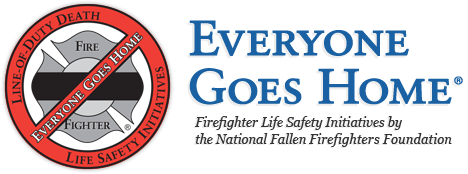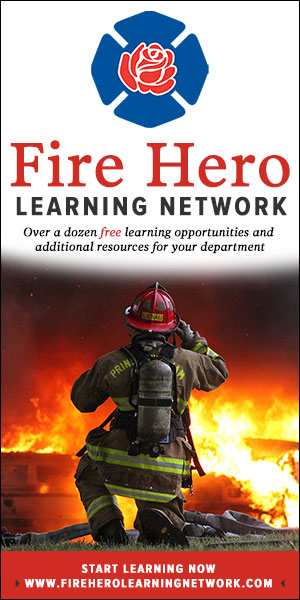By Lt. W. Greenwood
Courage to Be Safe® Trainer
Essay submitted as a part of the Courage to Be Safe® Trainers Essay Contest
There is no greater achievement for an educator than to identify and witness behavioral changes in a student whom you have influenced and educated. If and when that lifelong dream comes to fruition, one can personally acknowledge that in a way, their beliefs, challenges and efforts have come full circle.
There are only a few times within an educator’s career when a program comes along and shouts; “please institute me for the greater good of our service!” Within the last decade, for me, that epiphany occurred through my fire service career when I was introduced to the National Fallen Firefighters Foundation and the Everyone Goes Home® Firefighter Life Safety Initiatives Program. From the first time when I encountered the Courage to Be Safe® Train-The-Trainer program, I decided to embark on a mission and to leave my mark in the fire service. I wanted to do this by devoting time and energy toward doing my part to reduce the number of line-of-duty deaths.
The Courage to Be Safe® training program and the 16 Firefighter Life Safety Initiatives have both motivated me and given me assistance in my journey to complete this mission. If you have been in the fire service for any length of time, you may understand that the job of being an instructor can be a lonely one. More often than not, the position as trainer or instructor is looked upon as taking a step back from “the front line,” as looking for a change of pace, or even as a stepping stone toward retirement. These are some of the reasons why an educator who has dedicated his life to teaching others may feel such a profound joy when the student gets it. The instructor may also feel a sense of gratification that may be difficult for peers to comprehend.
The Courage to Be Safe(SM) Training Program has provided trainers and advocates with the tools and support system needed to positively effect change every time the program is delivered. This change is possible regardless of whether the attendee is paid, paid-on call, or volunteer. The program has many wonderful initiatives that I truly believe in. I have applied them to my own personal experiences and have drawn upon and implemented them in adjusting my own behaviors..
For example, in late 2004, I decided to invest in the protection of a residential sprinkler system for my home. By responding to the Everyone Goes Home® initiatives and researching the various data on residential sprinklers, I ultimately helped to provide my family with an 82% greater chance of surviving a fire in my home. I also learned that the sprinkler system could protect our property by providing us with up to two-thirds less property loss from fire damage as compared to living in a non-protected residential dwelling. This built-in protection is a very cost effective asset and a comfort when I am away from my family protecting the citizens I have sworn to serve.
The two biggest behavioral modifications I have seen with past Courage to Be Safe® attendees would be an understanding of the need to strap-in and stay-in and also instituting real emergency response procedures that focus on safe apparatus operations. The Courage to Be Safe® program clearly identifies the definition of insanity. By emphasizing the consequences of traditional mindsets, it has become a grim reminder to open our thoughts towards changing the safety culture throughout the fire service.
The second personal experience I would identify with is within the firefighter health and wellness initiative. I have witnessed firefighters asking fire chiefs why they have not had a medical evaluation per industry standards. Then following a Courage to Be Safe® presentation, I have watched as joint labor-management negotiations unfolded to seek an agreeable Health and Wellness Program for all.
On a regular basis, we are starting to see an increase in reports of how seat belts have saved firefighters during apparatus related motor vehicle accidents. These reports are a further testament to the effectiveness of the Courage to Be Safe® training program. I would like to point out though, that even with the success we have seen in the short time since the program’s inception, there still is hard work to be done to meet our goals. I would like to challenge all Everyone Goes Home® state advocates to realign your commitment toward the mission of reducing your state’s numbers.
If you feel you are stuck in a rut towards ideas for future deliveries and venues, then turn your attention towards other sources of assistance. For instance, if your state fire academy is not currently presenting or supporting the program, I would attempt to get the program included into a recruit or rookie school curriculum. Another option is to offer the program at a local, county or regional fire school. Lastly, I would recommend making contact with your local government. They may offer municipal government liability protection, insurances and education. These organizations all provide many wonderful training opportunities to reduce liability and risk…which sounds exactly what the Courage to Be Safe® training program is all about.
As Courage to Be Safe® Instructor, I would like to personally thank all of the survivors who contributed to the life safety summit and assisted in the research and development of the life safety initiatives. The ultimate tribute to a lost brother or sister firefighter should be celebrated each and every time another firefighter lives to respond another day. Without your personal involvement as a surviving family member, without living through your heartfelt stories and the ability to view the numerous memorials within the Courage to Be Safe® training program, this program would definitely not have impact it currently does. With that said, a tip of my cap to all of you who have rededicated your loved one’s commitment so others can have a safer working environment. Lastly, to all the men and women who have died in the line of duty, we may have lost your strength and presence but we as a service have gained insurmountable information to further protect and serve your fellow man.
Lt. W. Greenwood is a 16 year veteran of the fire service with experience in various volunteer, paid-call, and career fire departments throughout the State of New Hampshire. He holds a board of directors seat with the Fire Instructors and Officers Association of New Hampshire. He currently is working as a Career Lieutenant with the City of Keene, New Hampshire Fire Department and owns an advanced firefighter training and leadership company called FETC Services.


